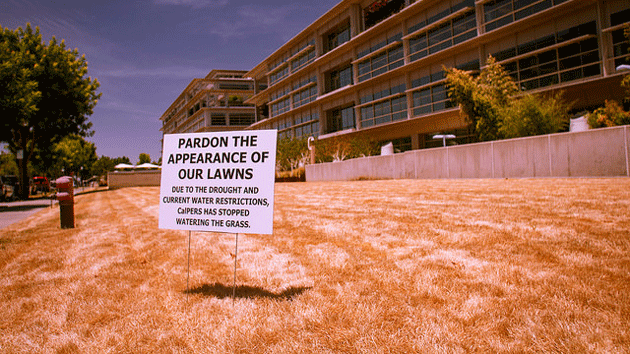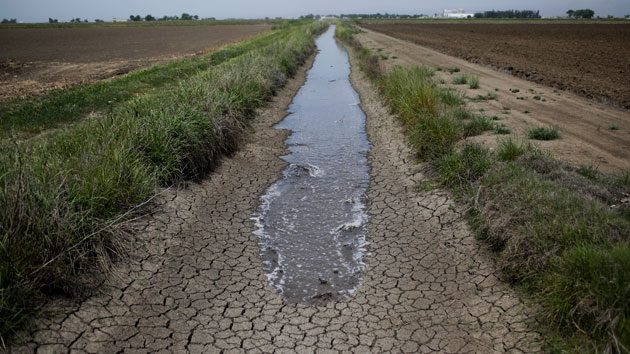
<a href="https://www.flickr.com/photos/kevincortopassi/14483258916/in/photolist-o4QuhC-axC8sY-mibhzg-oB5Bwq-owuBrU-9vAdPD-82dioP-7CzMSt-jCCd5H-eK4TT-midhHN-amD5qM-7XeRXt-nr8UhW-jtSnYu-6MUhzN-6aYB5D-a3Myb9-jMM6wm-jMJR5k-jMKCL8-arxPqT-hK6tNW-oA17R9-9tU7ce-ooJYjf-6mQAAp-o1aM3c-e4ZiGV-64b2Ej-mic5tZ-j74pZk-kZZ5sx-6vFers-6MUeaJ-kiniso-k13aHp-k13byH-mibZWH-ouqChL-bqoQNU-mibcSR-nLyC3E-mibjui-ojoRZr-miaksR-miatuT-mid93G-mic49z-6BG7oo">Kevin Cortopassi</a>/Flickr
“Water flows uphill towards money,” a source told Marc Reisner in Cadillac Desert, the seminal book on California water politics. Today the complex web of political interests that Reisner detailed some 30 years ago has become even more arcane and intertwined. As California confronts its worst drought in years, these power brokers will largely determine who gets water, and who gets left high and dry:
Dianne Feinstein: The chair of the powerful energy and water panel of the Senate Appropriations Committee has a history of siding with the state’s agricultural interests, which use 80 percent of the state’s water. In a March email to two Cabinet secretaries, Feinstein joined Republicans in urging federal water officials to capture “the maximum amount of water” from the Sacramento San Joaquin River Delta for farmers. Two months later, she pushed a drought bill through the Senate by a unanimous vote, over the objections of environmentalists who said it would open the door to permanently increasing water allocations to farmers at the expense of endangered fish. Environmental groups “have never been helpful to me in producing good water policy,” she later told the San Francisco Chronicle. She is now hammering out a compromise bill with House Republicans who want to do even more to gut endangered species laws.

Stewart & Lynda Resnick: The Beverly Hills billionaires own a chunk of farmland in Southern California that’s larger than four San Franciscos. It includes Paramount Farming Company, the world’s largest pistachio and almond growing and processing operation, and Paramount Citrus, the country’s leading producer of fresh citrus. The couple also owns Fiji Water, Pom Wonderful, and Teleflora, the nation’s largest flower delivery business. In the 1990s the Resnicks gained control of what was originally meant to be a state-owned water storage bank; it now sells water back to the state at a premium. Since 1993, they’ve donated nearly $5 million to state and federal campaigns and candidates—typically to whomever is in power. They threw a party at their Beverly Hills mansion for Feinstein and entertained her at their second home in Aspen, Colorado. In 2009, Feinstein sent a letter two Obama cabinet secretaries on the Resnicks’ behalf that helped convince the feds to delay a plan to curtail delta water diversions for the sake of endangered fish. Feinstein’s new Senate water bill would allow delta water to reach California’s Kern County, where it would be available to the Resnicks’ water bank.
Westlands Water District: The largest agricultural water district in the United States, Westlands, in the heart of the Central Valley, often incites controversy due to its size, its reliance on water from the ecologically sensitive rivers, and its heavy political expenditures. Last year, the district spent more than $600,000 on federal lobbying. Despite its size and wealth, Westlands holds only junior water rights, which means that its contract with the federal government puts it last in line for water deliveries; the drought will prevent Westlands from receiving any federally managed irrigation water this year—unless its 600 farms can pull some political strings. Last week, Westlands petitioned a judge to halt the planned release of 25,000 acre-feet of water from Northern California’s Trinity Lake to aid endangered salmon in the Klamath River. “It’s like having four thirsty kids in the car and saying you don’t have money for them to drink, and then you pull up on the street and give money to someone else,” Westlands farmer Mark Borba told the Wall Street Journal. Though Westlands landowners often portray themselves as family farmers and crucial employers, most of the district consists of highly mechanized operations owned by large corporate conglomerates.
the metropolitan water district of southern california: By far the state’s largest urban water district, the Met supplies the taps about half of all Californians—some 19 million people living in Los Angeles, San Diego, and surrounding cities. It sucks up water from all over the West, including the Colorado River and the Sacramento-San Joaquin River Delta, making it a player in just about any aspect of water politics. Though the district supports conservation measures such as rebates for low-flow toilets and incentives for water recycling, it’s less progressive than some smaller water districts such as the Sonoma County Water Agency, which, for example, provides some customers with high-efficiency water fixture upgrades at no cost. During the 1990s, the Met built and filled reservoirs that have (so far) prevented Southern Californians from resorting to the kinds of conservation measures seen during the drought of 1977, when restaurants were banned from automatically serving water to their customers. It’s now supporting Proposition 1, a November ballot measure that would allocate $2.7 billion for additional water storage projects while also investing money in watershed restoration.
The Association of California Water Agencies: When this coalition’s 430 agricultural and urban water districts agree on something, chances are good that it will happen. Last week, the association lent crucial support to the passage of a bill that will make California the last Western state to regulate the pumping of groundwater, a dwindling resource that has been removed from the Central Valley at twice the rate that it’s replaced by precipitation. Though riven with debate over the bill, the association ultimately lent its support after winning some ag-friendly concessions and the funding for dams included in Proposition 1. “There’s part of the groundwater legislation that’s going to have us doing some very painful things locally,” Tim Quinn, the association’s powerful executive director, told the New York Times. But, he added, “Groundwater management is part of a good solution to a problem, a solution that doesn’t involve a contraction of the economy.”
Environmental Groups: Influential among coastal politicians and the urban environmentalists who elect them, a slew of environmental groups have something to say about California water politics. Those supporting Proposition 1 include Clean Water Action, American Rivers, Audubon Society, California League of Conservation Voters, California Trout, California Waterfowl Association, Defenders of Wildlife, Ducks Unlimited, Natural Resources Defense Council, the Nature Conservancy, and Trout Unlimited. Notably absent from that list are Friends of the River and the California chapter of the Sierra Club, which are pushing for an alternative bond measure that would allocate more money to conservation, efficiency, and recycling projects.
community water center: Arguing that “clean water is a basic human right, not a privilege,” the CWC, which advocates on behalf of poor communities, has upended the traditional triad of urban, agricultural, and environmental interests that typically dominates California water politics. Last month, the group was brought into last-minute negotiations between key lawmakers and Gov. Jerry Brown’s office to ensure that the water bond measure would meet the needs of disadvantaged groups; the final measure commits a minimum of $691 million to helping localities gain access to clean drinking water. The CWC has highlighted the plights of rural, low-income, predominantly Latino towns such as East Orosi, Cutler, and Monson, which rely on contaminated and unreliable sources of water even when a cleaner supply passes nearby on its way to wealthy cities in Southern California. The increasing power of the CWC in Sacramento reflects its influence among California’s growing cohort of Latino state legislators.

resources legacy fund: Founded and run by the the lawyer Michael Mantell, a former California state undersecretary for resources for Republican Gov. Pete Wilson, the Sacramento-based Resources Legacy fund dominates Golden State water philanthropy. With a $37 million budget, the fund last year doled out more than $11 million in grants to a slew of water-related nonprofits, from the Alliance for Water Efficiency to the Yuba County Water Agency. In addition, the RLF does its own research and advocacy through its influential California Water Foundation, which is run by Lester Snow, the former Secretary of Natural Resources under Gov. Arnold Schwarzenegger; the foundation’s recent report on California’s groundwater problems is credited with spurring the state Legislature to take action. As if all of that wasn’t enough, the RLF also spent more than $500,000 on lobbying in favor of sustainability measures last year, including $225,000 in Sacramento, where it weighed in on the water bond.
Eric Garcetti: “Something radical must be done” to address Los Angeles’ thirst for water, the LA mayor proclaimed last year, echoing the words of his predecessor Frederick Eaton, who’d said the same thing more than 100 years ago. But rather than pushing for a return to LA’s Chinatown roots, Garcetti was advocating a radical shift towards sustainability. He was addressing the One Water Leadership Summit hosted by the US Water Alliance, which advocates breaking down barriers between the management of storm, waste, and drinking water in order to dramatically increase water recycling. Garcetti wants to capture and use some 30 billion gallons of urban runoff in the region by expanding the use of graywater and collecting water in “residential rain barrels.” In June he was in Sacramento trying to insert some of those ideas into the state water bond: “I don’t think there’s enough probably in the older bond that has that,” he told the LA Times.

Also read: This hedge-fund manager stands to make a killing as the West dries up.













